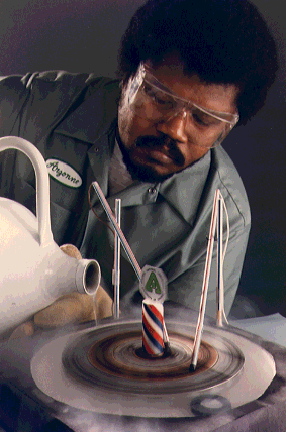Kowsky-Frost Quartz Levitation - 03/22/01
Reprinted from the September, 1927 issue of Science and Invention
Quartz Crystals Charged by High Frequency Current Lose their Weight
Although some remarkable achievements have been made with shortwave low power transmitters, radio experts and amateurs have recently decided that short-wave transmission had reached its ultimate and that no vital improvement would be made in this line. A short time ago, however, two young European experimenters working with ultra short-waves, have made a discovery that promises to be of primary importance to the scientific world.
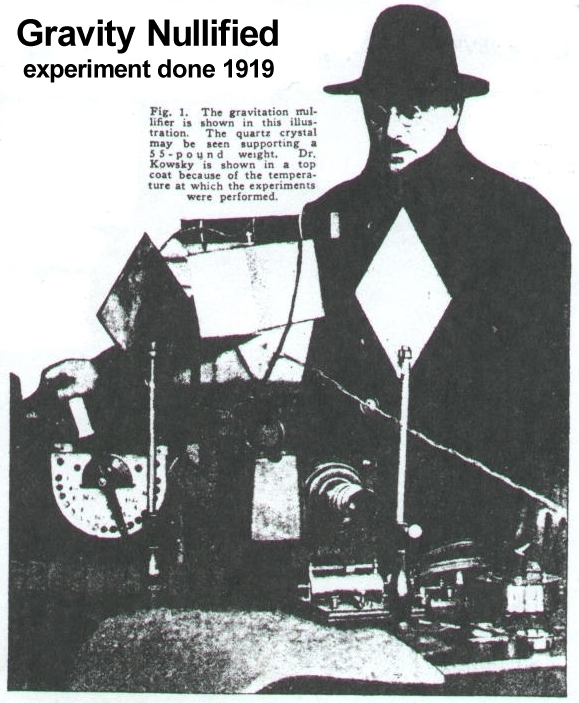
Figure 1
The gravitation nullifier is shown in this illustration. The quartz crystal may be seen supporting a 55 pound weight. Dr. Kowsky is shown in a topcoat because of the temperature at which the experiments were performed.
The discovery was made about six weeks ago in a newly established central laboratory of the Nessartsadding-Werke in Darredein, Poland, by Dr. Kowsky and Engineer Frost.
While experimenting with the constants of very short waves, carried on by means of quartz resonators, a piece of quartz which was used, suddenly showed a clearly altered appearance. It was easily seen that in the center of the crystal, especially when a constant temperature not exceeding ten degrees C. (50 degrees F.) was maintained, milky cloudiness appeared which gradually developed to complete opacity.
The experiments of Dr. Meissner, of the Telefunken Co., along similar lines, according to which quartz crystals, subjected to high frequency currents clearly showed air currents which led to the construction of a little motor based on this principle.
A week of eager experimenting finally led Dr. Kowsky and Engineer Frost to the explanation of the phenomenon, and further experiments showed the unexpected possibilities for technical uses for the discovery.
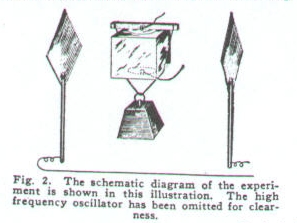
Figure 2 The schematic diagram of the experiment is shown in this illustration. The high frequency oscillator has been omitted for clearness. (Note: the two plates on top and bottom of the crystal which are driven by the high frequency oscillator - the vertical plates to the left and right appear to be electrostatic field emitters)
Some statements must precede the explanation. It is known at least in part, that quartz and some other crystals of similar atomic nature, have the property when exposed to potential excitation in a definite direction, of stretching and contracting; and if one uses rapidly changing potentials, the crystals will change the electric waves into mechanical oscillations.
This piezoelectric effect, shown in Rochelle salt crystals by which they may be made in sound-producing devices such as loudspeakers, or reversely into microphones, also shows the results in this direction. This effect was clearly explained in August, 1925 Radio News and December, 1919 Electrical Experimenter.
These oscillations are extremely small, but have nevertheless their technical use in a quartz crystal wave-meter and in maintaining a constant wavelength in radio transmitters. By a special arrangement of the excitation of the crystal in various directions, it may be made to stretch or increase in length and will not return to its original size.
It seems as if a dispersal of electrons from a molecule resulted, which, as it is irreversible, changes the entire structure of the crystal, so that it cannot be restored to its former condition.
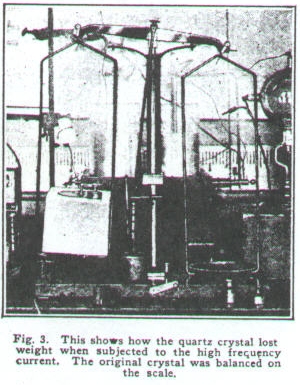
Figure 3 This shows how the quartz crystal lost weight when subjected to the high frequency current. The original crystal was balanced on the scale.
The stretching out, as we may term this strange property of the crystal, explains the impairment of its transparency. At the same time a change takes place in its specific gravity. Testing it on the balance showed that after connecting the crystal to the high tension current, the arm of the balance on which the crystal with the electrical connections rests, rose into the air. The illustration, (above as Fig. 3), shows this experiment.
This pointed the way for further investigation and the determination of how far the reduction of the specific gravity could be carried out. By the use of greater power, finally to the extent of several kilowatts and longer exposure to the action, it was found eventually that from a little crystal, 5 by 2 by 1.5 millimeters, a non-transparent white body measuring about ten centimeters on the side resulted, or increased about 20 times in length on any side (see Fig. 4 below).
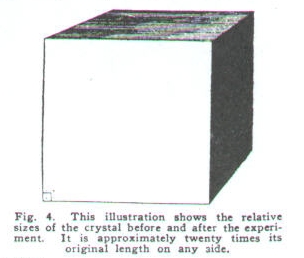
Figure 4This illustration shows the relative sizes of the crystal before and after the experiment. It is approximately twenty times its original length on any side. (original crystal size is located in the lower left corner)
The transformed crystal was so light that it carried the whole apparatus with itself upwards, along with the weight of twenty-five kilograms (55 lbs.) suspended from it and floating free in the air.
On exact measurement and calculations, which on account of the excellent apparatus in the Darredein laboratory, could be readily carried out, it was found that the specific gravity was reduced to a greater amount than the change in volume would indicate. Its weight had become practically negative.
There can be no doubt that a beginning has been made toward overcoming gravitation. It is to be noted, however, that the law of conservation of energy is absolutely unchanged. The energy employed in treating the crystal, appears as the counter effect of gravitation. Thus the riddle of gravitation is not fully solved as yet, and the progress of experiments will be followed further.
It is, however, the first time that experimentation with gravitation, which hitherto has been beyond the pale of all such research, has become possible, and it seems as if there were a way discovered at last to explain the inter-relations of gravity with electric and magnetic forces, which connection, long sought for, has never been demonstrated. This report appears in a reliable German journal, "Radio Umschau."


Figure 1 The gravitation nullifier is shown in this illustration. The quartz crystal may be seen supporting a 55 pound weight. Dr. Kowsky is shown in a topcoat because of the temperature at which the experiments were performed.
|
|
|
|
|
|
|
|
|
|
|
|
